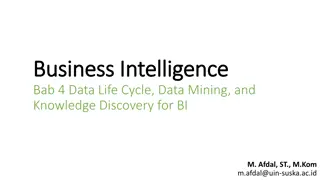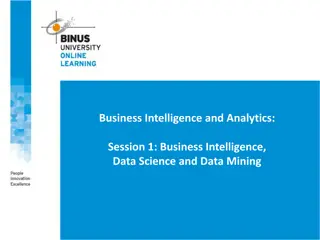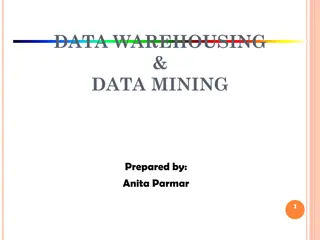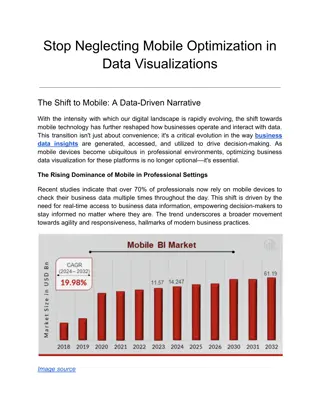Evolution of Business Intelligence: From Data Mining to Mobile BI
Business Intelligence (BI) has evolved through various stages, starting with historical data mining methods to the current era of Mobile and Location-based BI. The evolution includes the use of OLAP technologies, Balanced Scorecard methodology, Web analytics, and Business Dashboard technology to enhance decision-making processes. BI addresses key questions, supports operational efficiency, customer interaction, forecasting, planning, and targets across various business functions.
Uploaded on Nov 24, 2024 | 0 Views
Download Presentation

Please find below an Image/Link to download the presentation.
The content on the website is provided AS IS for your information and personal use only. It may not be sold, licensed, or shared on other websites without obtaining consent from the author. Download presentation by click this link. If you encounter any issues during the download, it is possible that the publisher has removed the file from their server.
E N D
Presentation Transcript
INTRODUCTION TO BUSINESS INTELLIGENCE (BI) UNIT-1 By: Prof. K.V. PAVAN KUMAR, Methodist College of Engg & Tech., Abids, Hyd.
1. BUSINESS INTELLIGENCE - DEFINITION: The term Business Intelligence refers to applications and practices for the collection, integration, analysis, and presentation information. The purpose Intelligence is to support better business decision making. (BI) technologies, of business of Business
HISTORY AND EVOLUTION OF BUSINESS INTELLIGENCE: At the very beginning, historical data mining methods and tools were used for strategic managerial reporting purposes. The second evolutionary stage is characterized by On-Line Analytic Processing (OLAP) technologies and dimensional analysis of data stored in data warehouses and data marts.
In the third stage Balanced Scorecard methodology is used as a means of Business Intelligence creation. With the emergence and growing popularity of EBusiness and other Internet applications and services the new stage of BI appeared since Web analytics and Web mining as a form of BI began to attract the wide professional attention.
The fifth development stage started when usage of Business Dashboard technology became a core component of alerting and alarming systems in business decision-making supported by BI. Finally, nowadays we are witnessing the era of Mobile and location- based Business Intelligence founded on appropriate mobile and location- aware technologies.
BI QUESTIONS What happened? What were our total sales this month? What s happening? Are our sales going up or down, trend analysis Why? Why have sales gone down? What will happen? Forecasting & What If Analysis What do I want to happen? Planning & Targets
WHERE IS BUSINESS INTELLIGENCE APPLIED? Operational Efficiency Customer Interaction ERP Reporting KPI Tracking Product Profitability Risk Management Balanced Scorecard Activity Based Costing Global Sourcing Logistics Sales Analysis Sales Forecasting Segmentation Cross-selling CRM Analytics Campaign Planning Customer Profitability
2. STYLES OF BUSINESS INTELLIGENCE: There are 5 Styles of BI, which are presented below: 1) Enterprise Reporting - Broadly deployed pixel-perfect report formats for operational reporting and scorecards/dashboards targeted at information consumers and executives.
2) Cube Analysis - OLAP slice-and-dice analysis of limited data sets, targeted at managers and others who need a safe and simple environment for basic data exploration within a limited range of data. 3) Ad Hoc Query and Analysis - Full investigative query into all data, as well as automated slice and-dice OLAP analysis of the entire database - down to the transaction level of detail if necessary. Targeted at information explorers and power users.
4) Statistical Analysis and Data Mining - Full mathematical, financial, and statistical treatment of data for purposes of correlation analysis, trend analysis, financial analysis and projections. Targeted at the professional information analysts. 5) Alerting and Report Delivery - Proactive report delivery and alerting to very large populations based on schedules or event triggers in the database. Targeted at very large user populations of information consumers, both internal and external to the enterprise.
3. TYPES OF BUSINESS INTELLIGENCE TOOLS: The following are the types of Business Intelligence Tools: a) Spreadsheets These interactive Computer Applications manage information in a visual format. b) Reporting and Querying Software These tools extract, sort and summarize data. There is a variety of software programs used to present this data, including open-source and commercial software types.
c) Online Analytical Processing This processing approach quickly answers queries that are multi-dimensional. The types of applications included in this processing include business reporting, marketing, budget and forecasting. d) Data Mining Data mining is the bridge between statistics and computer science. It is used to uncover patterns in large sets of data.
e) Data Warehousing This comprehensive database is used for reporting and data analysis. The information is uploaded from a separate operational system. f) Process Mining This process management technique logs various events to determine business processes. Process mining provides techniques and tools that will discover control data, process and social structures from event logs.
g) Digital Dashboards A single page interface in real-time that show at-a- glance information. h) Decision Engineering A frameword that utilizes the best practices for organizational decisional making. It helps businesses make decisions based on a variety of business approaches. i) Business Performance Management Management and Analytic Processes that manage a business performance to achieve short and long-term goals.
4. BENEFITS OF BUSINESS INTELLIGENCE: The following are the benefits of Business Intelligence: Faster reporting, analysis or planning More accurate reporting, analysis or planning Better business decisions Improved data quality Improved employee satisfaction Improved operational efficiency Improved customer satisfaction Increased competitive advantage Reduced costs Increased revenues Saved headcount
BI APPLICATIONS & TECHNOLOGIES CAN HELP COMPANIES ANALYSE: Changes trends in Shares Changes in customer behavior and spending patterns Customers' preferences Company capabilities Market conditions
SIGNIFICANCE OF BI: Companies need to have accurate, up-to-date information on customer preferences . So that company can quickly adapt to their changing demands. BI applications can also help managers to be better informed about actions that a company s competitors are taking.
It helps analysts and managers to determine which adjustments are most likely to respond to changing trends. IT can help companies develop a more consistent, decision, which can produce better results than making business decisions by guesswork . data-based
1) Dashboards 2) Key PerformanceIndicators 3) GraphicalOLAP 4) Forecasting 5) GraphicalReporting
BI DASH BOARDS: BI dashboards customized operations, and assist the identifying problems andthesourceof those problems, as well as providing valuable, up-to-date about financial results, sales and other critical information all in one place can provide of a snapshot daily user in information
KEY PERFORMANCEINDICATORS BI provides simplified KPI management and tracking withpowerfulfeatures,formulaeand expressions,and flexible frequency, and threshold levels. This module enables clear, concise definition and tracking of performance indicators for a period, and measures performanceascomparedtoa previousperiod. Intuitive, color highlighters ensure that users can see these indicators in a clear manner and accurately present information to management and team members.Userscanfurtheranalyse performancewith easy-to-usefeatureslikedrill down,drillthrough,slice anddiceandgraphicaldata mining
GRAPHICAL BI: GraphicalBusinessIntelligence(BI)OLAP technology makes it easy for the users to find, filter and analyse data, going beyond numbers,andallowinguserstovisualizethe information with eye-catching, stunning displays, and valuable indicators and gauges,charts,andavarietyofgraphtypes fromwhichtochoose
inFORECASTING & PREDICTIVE ANALYSIS: Predictive analysis uses historical product,sales,pricing,financial, budgetand otherdata,and forecaststhemeasureswith numerous timeseries options, Ex: year,quarter,month,week,day, hourorevensecondtoimproveyour planning process.
BI REPORTS: BIReportsdelivers web-basedBIreports to anyone (or everyone) in the organization withinminutes! TheBIsuiteissimpleto use,practicaltoimplementandaffordable for every organization. With our BI reporting and performancereporting module,youjustpoint- and-click and drag- and-drop and you can instantly create a report to summarize your performance metrics,oroperationaldata
5. REAL-TIME BUSINESS INTELLIGENCE: Real-time business intelligence (RTBI) is a concept describing the process of delivering business intelligence (BI) or information about business operations as they occur. Real time means near to zero latency and access to information whenever it is required.
DATA LATENCY 1. Data latency is the time it takes for data Packets to be stored or retrieved. 2. In business intelligence (BI), data latency is how long it takes for a business user to retrieve source data from a data warehouse or business intelligence dashboard.
BI IN DECISION-MAKING: With high consumer expectations in the competitive market, decisions that are based on the most current data available improve customer relationships, increase revenue, maximize operational efficiency. Real-time business intelligence systems mainly provide the information necessary to tactical take advantage of events as they occur.
SIGNIFICANCE OF LATENCY IN BI: All real-time business intelligence systems have some latency, but the goal is to minimize the time from the business event happening to a corrective action or notification being initiated. Analyst Richard Hackathorn describes three types of latency: 1. Data latency: the time taken to collect and store the data 2. Analysis latency: the time taken to analyze the data and turn it into actionable information 3. Action latency: the time taken to react to the information and take action
Real-time business intelligence technologies are designed to reduce all three latencies to as close to zero as possible, whereas traditional business intelligence only seeks to reduce data latency and does not address analysis latency or action latency since both are governed by manual processes. Some commentators have introduced the concept of right time business intelligence which proposes that information should be delivered just before it is required, and not necessarily in real-time.
6) BUSINESS INTELLIGENCE VALUE CHAIN: In Competitive Market place, it is vital for every business enterprise whether small or big to cope with the pace of the market growth. This is why organizations are becoming more dependent on data or information for improving development of product and services that can outsell their competitors.
Organizations are primarily relying on analytical database solutions like data warehouses. However, in the entire process this information and later applying them in action describes a chain of methods called value chain. Value chain is the process that converts data into information and then applies that knowledge in taking productive business decision, and the outcome is the ultimate value.
WHAT IS THE PRIMARY OBJECTIVE OF MOST ANALYTIC DECISION SUPPORT SYSTEMS? Monitor the performance results of Key Business Processes. Each business Process produces unique metrics at unique time intervals with unique granularity and dimensionality. Each process typically spawns one or more fact tables Value chain provides high-level insight into the overall enterprise data warehouse.
Product Chocolate CONCEPT OF A CUBE OR PIVOT TABLE Month May 2017 Region Hyderabad Measure Sales Month Region Product How much Chocolate did we sell in the Hyderabad in May 2017?
BUSINESS INTELLIGENCE VALUE CHAIN:
7) ARCHITECTURE BUSINESS INTELLIGENCE: A business intelligence architecture is a framework for organizing the data, information management and technology components that are used to build business intelligence (BI) systems for reporting and data analytics. The underlying BI architecture plays an important role in business intelligence projects because it affects development and implementation decisions.
The data components of a BI architecture include the data sources that corporate executives and other end users need to access and analyze to meet their business requirements.
Important criteria in the source selection process include data currency, data quality and the level of detail in the data. Both structured and unstructured data may be required as part of a BI architecture, as well as information from both internal and external sources.























